Nursing Case Study: Analysis of Nursing Care and Clinical Outcomes
VerifiedAdded on 2022/11/10
|10
|2805
|382
Case Study
AI Summary
This case study analyzes the clinical scenario of Ms. Jones, a 17-year-old woman admitted with pyelonephritis and a history of Type 1 Diabetes Mellitus. The analysis utilizes the clinical reasoning cycle to assess the patient's condition, including symptoms, vital signs, and the impact of diabetes. The study highlights key issues such as acute pyelonephritis, diabetic ketoacidosis, and the significance of effective communication and patient handover among nurses. The case study examines the importance of proper assessment, communication, and adherence to hospital protocols to ensure patient safety and improve outcomes. It also explores the impact of poor communication and its contribution to adverse patient outcomes. Relevant research articles are used to support the findings. The analysis emphasizes the need for nurses to possess the necessary skills to interpret patient data accurately and comprehensively to deliver high-quality nursing care. The case study also discusses the prevalence of diabetic ketoacidosis and the importance of early detection and management of diabetes. The study underscores the importance of clinical handover reports containing all necessary information on the patient’s health to ensure patient safety.
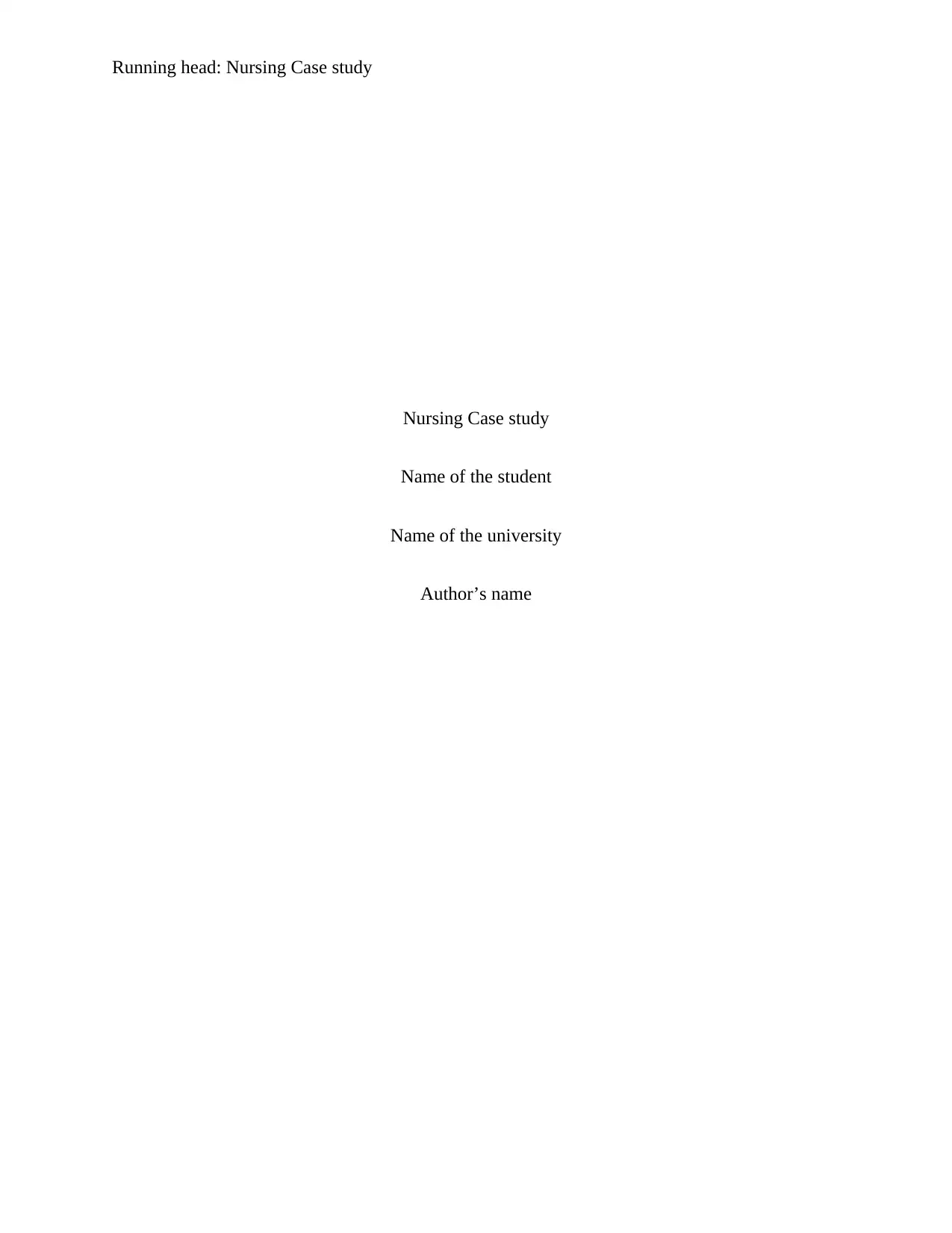
Running head: Nursing Case study
Nursing Case study
Name of the student
Name of the university
Author’s name
Nursing Case study
Name of the student
Name of the university
Author’s name
Paraphrase This Document
Need a fresh take? Get an instant paraphrase of this document with our AI Paraphraser
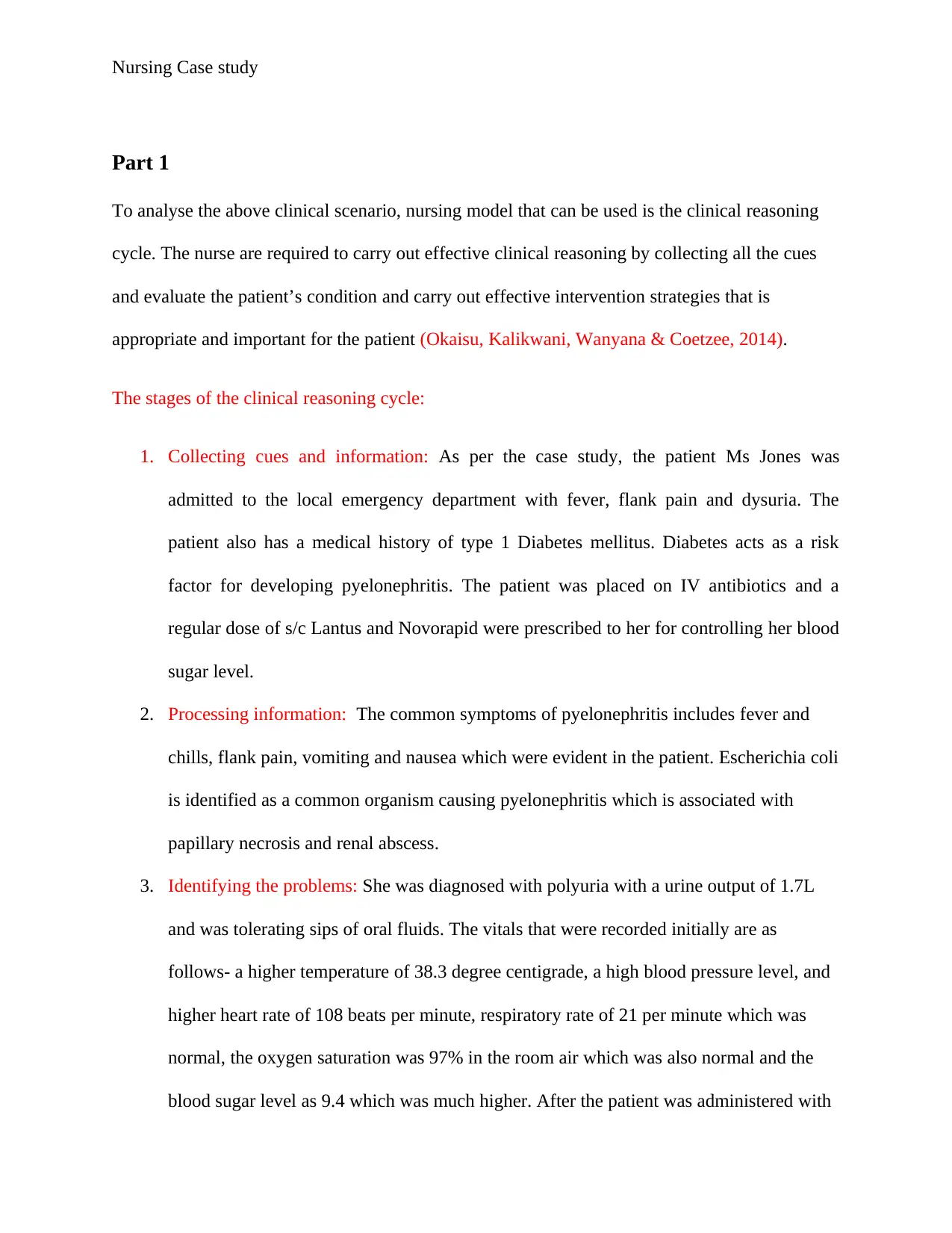
Nursing Case study
Part 1
To analyse the above clinical scenario, nursing model that can be used is the clinical reasoning
cycle. The nurse are required to carry out effective clinical reasoning by collecting all the cues
and evaluate the patient’s condition and carry out effective intervention strategies that is
appropriate and important for the patient (Okaisu, Kalikwani, Wanyana & Coetzee, 2014).
The stages of the clinical reasoning cycle:
1. Collecting cues and information: As per the case study, the patient Ms Jones was
admitted to the local emergency department with fever, flank pain and dysuria. The
patient also has a medical history of type 1 Diabetes mellitus. Diabetes acts as a risk
factor for developing pyelonephritis. The patient was placed on IV antibiotics and a
regular dose of s/c Lantus and Novorapid were prescribed to her for controlling her blood
sugar level.
2. Processing information: The common symptoms of pyelonephritis includes fever and
chills, flank pain, vomiting and nausea which were evident in the patient. Escherichia coli
is identified as a common organism causing pyelonephritis which is associated with
papillary necrosis and renal abscess.
3. Identifying the problems: She was diagnosed with polyuria with a urine output of 1.7L
and was tolerating sips of oral fluids. The vitals that were recorded initially are as
follows- a higher temperature of 38.3 degree centigrade, a high blood pressure level, and
higher heart rate of 108 beats per minute, respiratory rate of 21 per minute which was
normal, the oxygen saturation was 97% in the room air which was also normal and the
blood sugar level as 9.4 which was much higher. After the patient was administered with
Part 1
To analyse the above clinical scenario, nursing model that can be used is the clinical reasoning
cycle. The nurse are required to carry out effective clinical reasoning by collecting all the cues
and evaluate the patient’s condition and carry out effective intervention strategies that is
appropriate and important for the patient (Okaisu, Kalikwani, Wanyana & Coetzee, 2014).
The stages of the clinical reasoning cycle:
1. Collecting cues and information: As per the case study, the patient Ms Jones was
admitted to the local emergency department with fever, flank pain and dysuria. The
patient also has a medical history of type 1 Diabetes mellitus. Diabetes acts as a risk
factor for developing pyelonephritis. The patient was placed on IV antibiotics and a
regular dose of s/c Lantus and Novorapid were prescribed to her for controlling her blood
sugar level.
2. Processing information: The common symptoms of pyelonephritis includes fever and
chills, flank pain, vomiting and nausea which were evident in the patient. Escherichia coli
is identified as a common organism causing pyelonephritis which is associated with
papillary necrosis and renal abscess.
3. Identifying the problems: She was diagnosed with polyuria with a urine output of 1.7L
and was tolerating sips of oral fluids. The vitals that were recorded initially are as
follows- a higher temperature of 38.3 degree centigrade, a high blood pressure level, and
higher heart rate of 108 beats per minute, respiratory rate of 21 per minute which was
normal, the oxygen saturation was 97% in the room air which was also normal and the
blood sugar level as 9.4 which was much higher. After the patient was administered with
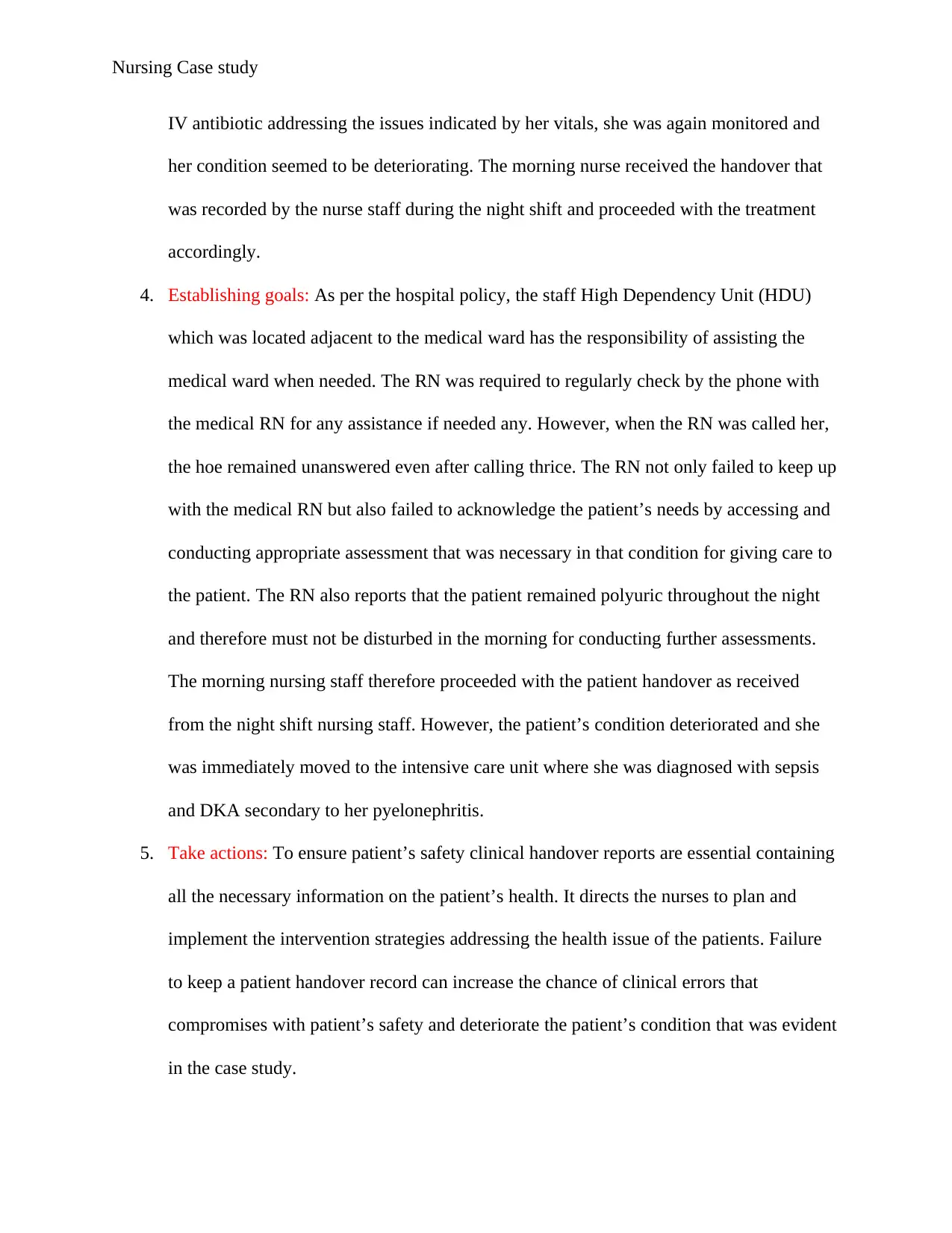
Nursing Case study
IV antibiotic addressing the issues indicated by her vitals, she was again monitored and
her condition seemed to be deteriorating. The morning nurse received the handover that
was recorded by the nurse staff during the night shift and proceeded with the treatment
accordingly.
4. Establishing goals: As per the hospital policy, the staff High Dependency Unit (HDU)
which was located adjacent to the medical ward has the responsibility of assisting the
medical ward when needed. The RN was required to regularly check by the phone with
the medical RN for any assistance if needed any. However, when the RN was called her,
the hoe remained unanswered even after calling thrice. The RN not only failed to keep up
with the medical RN but also failed to acknowledge the patient’s needs by accessing and
conducting appropriate assessment that was necessary in that condition for giving care to
the patient. The RN also reports that the patient remained polyuric throughout the night
and therefore must not be disturbed in the morning for conducting further assessments.
The morning nursing staff therefore proceeded with the patient handover as received
from the night shift nursing staff. However, the patient’s condition deteriorated and she
was immediately moved to the intensive care unit where she was diagnosed with sepsis
and DKA secondary to her pyelonephritis.
5. Take actions: To ensure patient’s safety clinical handover reports are essential containing
all the necessary information on the patient’s health. It directs the nurses to plan and
implement the intervention strategies addressing the health issue of the patients. Failure
to keep a patient handover record can increase the chance of clinical errors that
compromises with patient’s safety and deteriorate the patient’s condition that was evident
in the case study.
IV antibiotic addressing the issues indicated by her vitals, she was again monitored and
her condition seemed to be deteriorating. The morning nurse received the handover that
was recorded by the nurse staff during the night shift and proceeded with the treatment
accordingly.
4. Establishing goals: As per the hospital policy, the staff High Dependency Unit (HDU)
which was located adjacent to the medical ward has the responsibility of assisting the
medical ward when needed. The RN was required to regularly check by the phone with
the medical RN for any assistance if needed any. However, when the RN was called her,
the hoe remained unanswered even after calling thrice. The RN not only failed to keep up
with the medical RN but also failed to acknowledge the patient’s needs by accessing and
conducting appropriate assessment that was necessary in that condition for giving care to
the patient. The RN also reports that the patient remained polyuric throughout the night
and therefore must not be disturbed in the morning for conducting further assessments.
The morning nursing staff therefore proceeded with the patient handover as received
from the night shift nursing staff. However, the patient’s condition deteriorated and she
was immediately moved to the intensive care unit where she was diagnosed with sepsis
and DKA secondary to her pyelonephritis.
5. Take actions: To ensure patient’s safety clinical handover reports are essential containing
all the necessary information on the patient’s health. It directs the nurses to plan and
implement the intervention strategies addressing the health issue of the patients. Failure
to keep a patient handover record can increase the chance of clinical errors that
compromises with patient’s safety and deteriorate the patient’s condition that was evident
in the case study.
⊘ This is a preview!⊘
Do you want full access?
Subscribe today to unlock all pages.

Trusted by 1+ million students worldwide
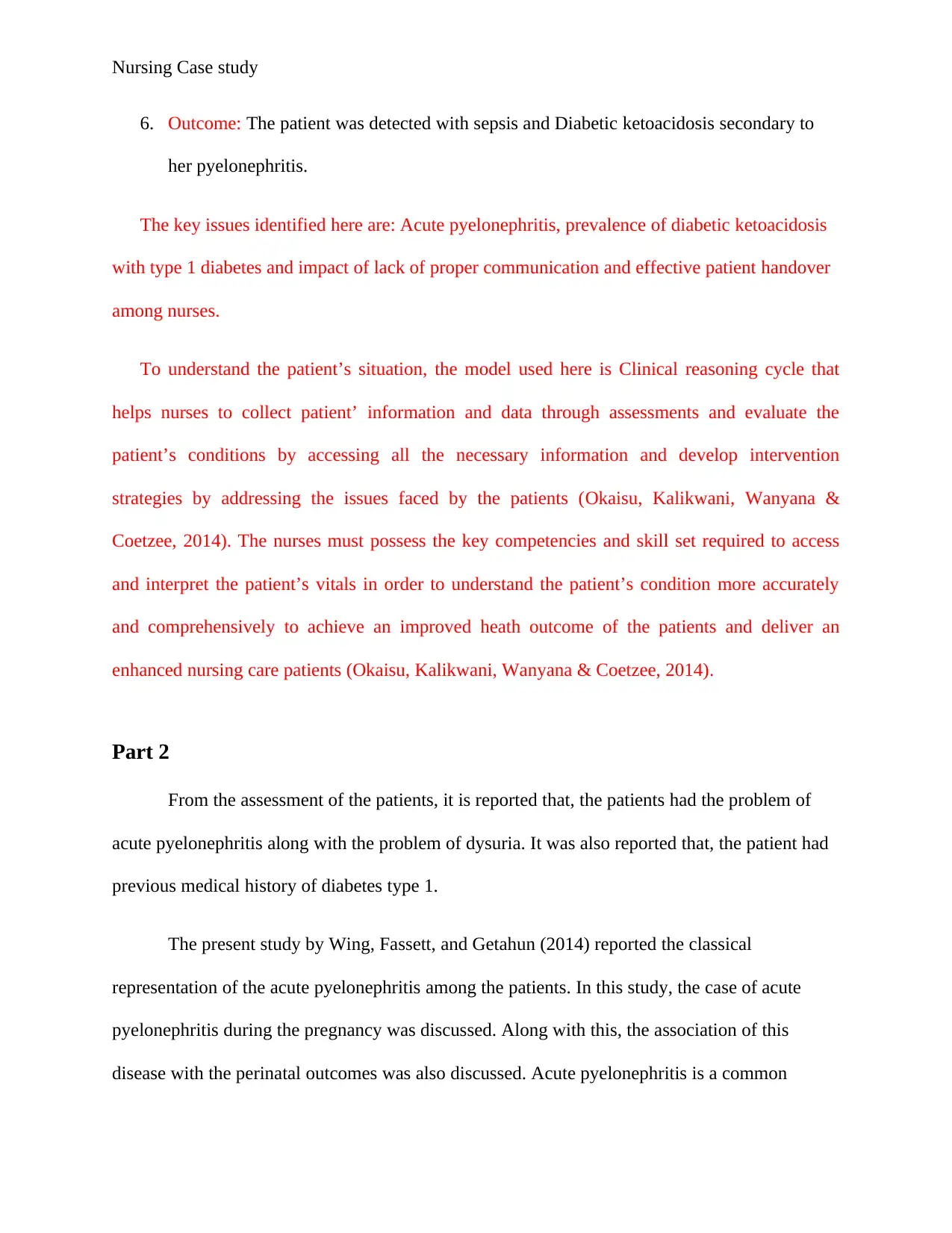
Nursing Case study
6. Outcome: The patient was detected with sepsis and Diabetic ketoacidosis secondary to
her pyelonephritis.
The key issues identified here are: Acute pyelonephritis, prevalence of diabetic ketoacidosis
with type 1 diabetes and impact of lack of proper communication and effective patient handover
among nurses.
To understand the patient’s situation, the model used here is Clinical reasoning cycle that
helps nurses to collect patient’ information and data through assessments and evaluate the
patient’s conditions by accessing all the necessary information and develop intervention
strategies by addressing the issues faced by the patients (Okaisu, Kalikwani, Wanyana &
Coetzee, 2014). The nurses must possess the key competencies and skill set required to access
and interpret the patient’s vitals in order to understand the patient’s condition more accurately
and comprehensively to achieve an improved heath outcome of the patients and deliver an
enhanced nursing care patients (Okaisu, Kalikwani, Wanyana & Coetzee, 2014).
Part 2
From the assessment of the patients, it is reported that, the patients had the problem of
acute pyelonephritis along with the problem of dysuria. It was also reported that, the patient had
previous medical history of diabetes type 1.
The present study by Wing, Fassett, and Getahun (2014) reported the classical
representation of the acute pyelonephritis among the patients. In this study, the case of acute
pyelonephritis during the pregnancy was discussed. Along with this, the association of this
disease with the perinatal outcomes was also discussed. Acute pyelonephritis is a common
6. Outcome: The patient was detected with sepsis and Diabetic ketoacidosis secondary to
her pyelonephritis.
The key issues identified here are: Acute pyelonephritis, prevalence of diabetic ketoacidosis
with type 1 diabetes and impact of lack of proper communication and effective patient handover
among nurses.
To understand the patient’s situation, the model used here is Clinical reasoning cycle that
helps nurses to collect patient’ information and data through assessments and evaluate the
patient’s conditions by accessing all the necessary information and develop intervention
strategies by addressing the issues faced by the patients (Okaisu, Kalikwani, Wanyana &
Coetzee, 2014). The nurses must possess the key competencies and skill set required to access
and interpret the patient’s vitals in order to understand the patient’s condition more accurately
and comprehensively to achieve an improved heath outcome of the patients and deliver an
enhanced nursing care patients (Okaisu, Kalikwani, Wanyana & Coetzee, 2014).
Part 2
From the assessment of the patients, it is reported that, the patients had the problem of
acute pyelonephritis along with the problem of dysuria. It was also reported that, the patient had
previous medical history of diabetes type 1.
The present study by Wing, Fassett, and Getahun (2014) reported the classical
representation of the acute pyelonephritis among the patients. In this study, the case of acute
pyelonephritis during the pregnancy was discussed. Along with this, the association of this
disease with the perinatal outcomes was also discussed. Acute pyelonephritis is a common
Paraphrase This Document
Need a fresh take? Get an instant paraphrase of this document with our AI Paraphraser
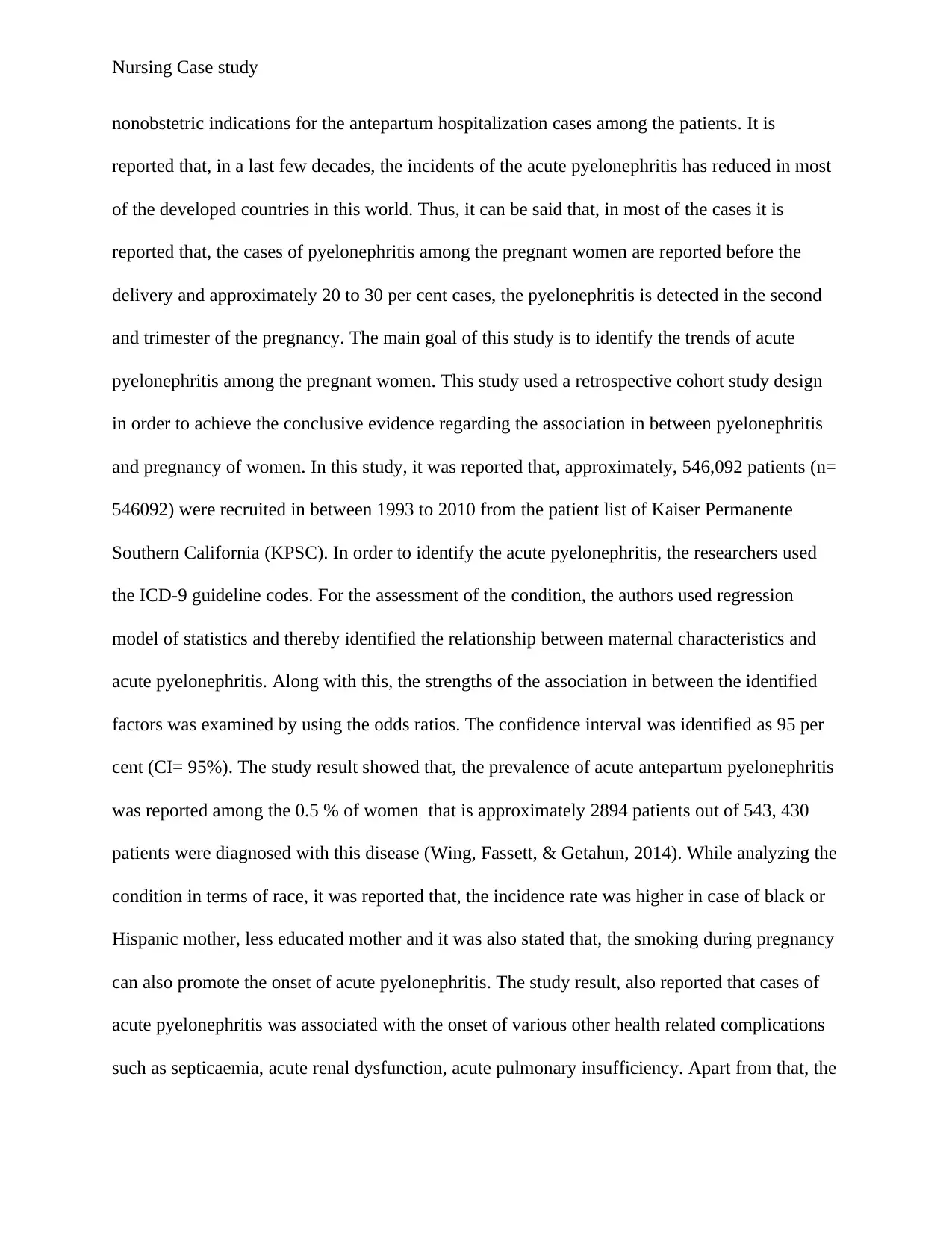
Nursing Case study
nonobstetric indications for the antepartum hospitalization cases among the patients. It is
reported that, in a last few decades, the incidents of the acute pyelonephritis has reduced in most
of the developed countries in this world. Thus, it can be said that, in most of the cases it is
reported that, the cases of pyelonephritis among the pregnant women are reported before the
delivery and approximately 20 to 30 per cent cases, the pyelonephritis is detected in the second
and trimester of the pregnancy. The main goal of this study is to identify the trends of acute
pyelonephritis among the pregnant women. This study used a retrospective cohort study design
in order to achieve the conclusive evidence regarding the association in between pyelonephritis
and pregnancy of women. In this study, it was reported that, approximately, 546,092 patients (n=
546092) were recruited in between 1993 to 2010 from the patient list of Kaiser Permanente
Southern California (KPSC). In order to identify the acute pyelonephritis, the researchers used
the ICD-9 guideline codes. For the assessment of the condition, the authors used regression
model of statistics and thereby identified the relationship between maternal characteristics and
acute pyelonephritis. Along with this, the strengths of the association in between the identified
factors was examined by using the odds ratios. The confidence interval was identified as 95 per
cent (CI= 95%). The study result showed that, the prevalence of acute antepartum pyelonephritis
was reported among the 0.5 % of women that is approximately 2894 patients out of 543, 430
patients were diagnosed with this disease (Wing, Fassett, & Getahun, 2014). While analyzing the
condition in terms of race, it was reported that, the incidence rate was higher in case of black or
Hispanic mother, less educated mother and it was also stated that, the smoking during pregnancy
can also promote the onset of acute pyelonephritis. The study result, also reported that cases of
acute pyelonephritis was associated with the onset of various other health related complications
such as septicaemia, acute renal dysfunction, acute pulmonary insufficiency. Apart from that, the
nonobstetric indications for the antepartum hospitalization cases among the patients. It is
reported that, in a last few decades, the incidents of the acute pyelonephritis has reduced in most
of the developed countries in this world. Thus, it can be said that, in most of the cases it is
reported that, the cases of pyelonephritis among the pregnant women are reported before the
delivery and approximately 20 to 30 per cent cases, the pyelonephritis is detected in the second
and trimester of the pregnancy. The main goal of this study is to identify the trends of acute
pyelonephritis among the pregnant women. This study used a retrospective cohort study design
in order to achieve the conclusive evidence regarding the association in between pyelonephritis
and pregnancy of women. In this study, it was reported that, approximately, 546,092 patients (n=
546092) were recruited in between 1993 to 2010 from the patient list of Kaiser Permanente
Southern California (KPSC). In order to identify the acute pyelonephritis, the researchers used
the ICD-9 guideline codes. For the assessment of the condition, the authors used regression
model of statistics and thereby identified the relationship between maternal characteristics and
acute pyelonephritis. Along with this, the strengths of the association in between the identified
factors was examined by using the odds ratios. The confidence interval was identified as 95 per
cent (CI= 95%). The study result showed that, the prevalence of acute antepartum pyelonephritis
was reported among the 0.5 % of women that is approximately 2894 patients out of 543, 430
patients were diagnosed with this disease (Wing, Fassett, & Getahun, 2014). While analyzing the
condition in terms of race, it was reported that, the incidence rate was higher in case of black or
Hispanic mother, less educated mother and it was also stated that, the smoking during pregnancy
can also promote the onset of acute pyelonephritis. The study result, also reported that cases of
acute pyelonephritis was associated with the onset of various other health related complications
such as septicaemia, acute renal dysfunction, acute pulmonary insufficiency. Apart from that, the
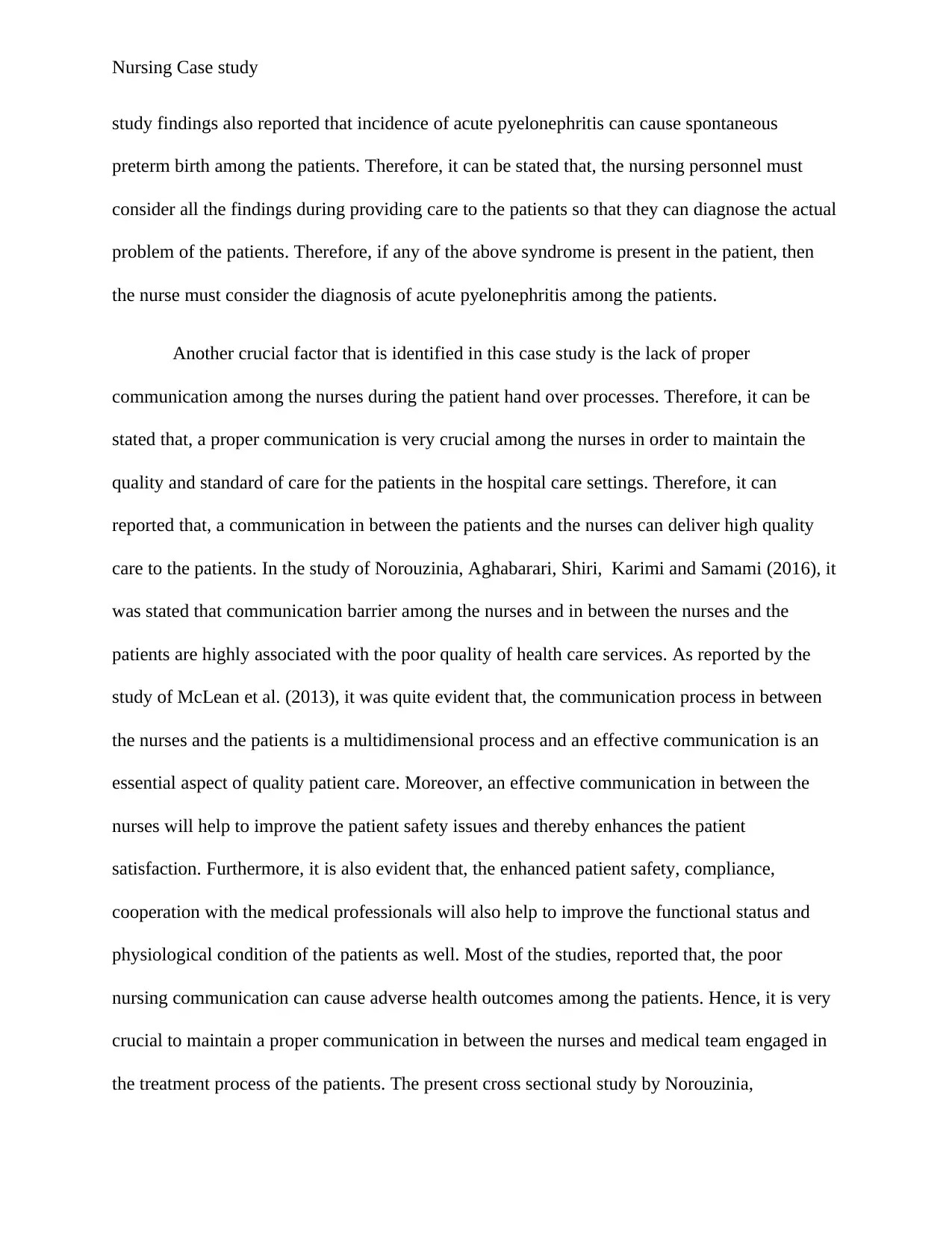
Nursing Case study
study findings also reported that incidence of acute pyelonephritis can cause spontaneous
preterm birth among the patients. Therefore, it can be stated that, the nursing personnel must
consider all the findings during providing care to the patients so that they can diagnose the actual
problem of the patients. Therefore, if any of the above syndrome is present in the patient, then
the nurse must consider the diagnosis of acute pyelonephritis among the patients.
Another crucial factor that is identified in this case study is the lack of proper
communication among the nurses during the patient hand over processes. Therefore, it can be
stated that, a proper communication is very crucial among the nurses in order to maintain the
quality and standard of care for the patients in the hospital care settings. Therefore, it can
reported that, a communication in between the patients and the nurses can deliver high quality
care to the patients. In the study of Norouzinia, Aghabarari, Shiri, Karimi and Samami (2016), it
was stated that communication barrier among the nurses and in between the nurses and the
patients are highly associated with the poor quality of health care services. As reported by the
study of McLean et al. (2013), it was quite evident that, the communication process in between
the nurses and the patients is a multidimensional process and an effective communication is an
essential aspect of quality patient care. Moreover, an effective communication in between the
nurses will help to improve the patient safety issues and thereby enhances the patient
satisfaction. Furthermore, it is also evident that, the enhanced patient safety, compliance,
cooperation with the medical professionals will also help to improve the functional status and
physiological condition of the patients as well. Most of the studies, reported that, the poor
nursing communication can cause adverse health outcomes among the patients. Hence, it is very
crucial to maintain a proper communication in between the nurses and medical team engaged in
the treatment process of the patients. The present cross sectional study by Norouzinia,
study findings also reported that incidence of acute pyelonephritis can cause spontaneous
preterm birth among the patients. Therefore, it can be stated that, the nursing personnel must
consider all the findings during providing care to the patients so that they can diagnose the actual
problem of the patients. Therefore, if any of the above syndrome is present in the patient, then
the nurse must consider the diagnosis of acute pyelonephritis among the patients.
Another crucial factor that is identified in this case study is the lack of proper
communication among the nurses during the patient hand over processes. Therefore, it can be
stated that, a proper communication is very crucial among the nurses in order to maintain the
quality and standard of care for the patients in the hospital care settings. Therefore, it can
reported that, a communication in between the patients and the nurses can deliver high quality
care to the patients. In the study of Norouzinia, Aghabarari, Shiri, Karimi and Samami (2016), it
was stated that communication barrier among the nurses and in between the nurses and the
patients are highly associated with the poor quality of health care services. As reported by the
study of McLean et al. (2013), it was quite evident that, the communication process in between
the nurses and the patients is a multidimensional process and an effective communication is an
essential aspect of quality patient care. Moreover, an effective communication in between the
nurses will help to improve the patient safety issues and thereby enhances the patient
satisfaction. Furthermore, it is also evident that, the enhanced patient safety, compliance,
cooperation with the medical professionals will also help to improve the functional status and
physiological condition of the patients as well. Most of the studies, reported that, the poor
nursing communication can cause adverse health outcomes among the patients. Hence, it is very
crucial to maintain a proper communication in between the nurses and medical team engaged in
the treatment process of the patients. The present cross sectional study by Norouzinia,
⊘ This is a preview!⊘
Do you want full access?
Subscribe today to unlock all pages.

Trusted by 1+ million students worldwide
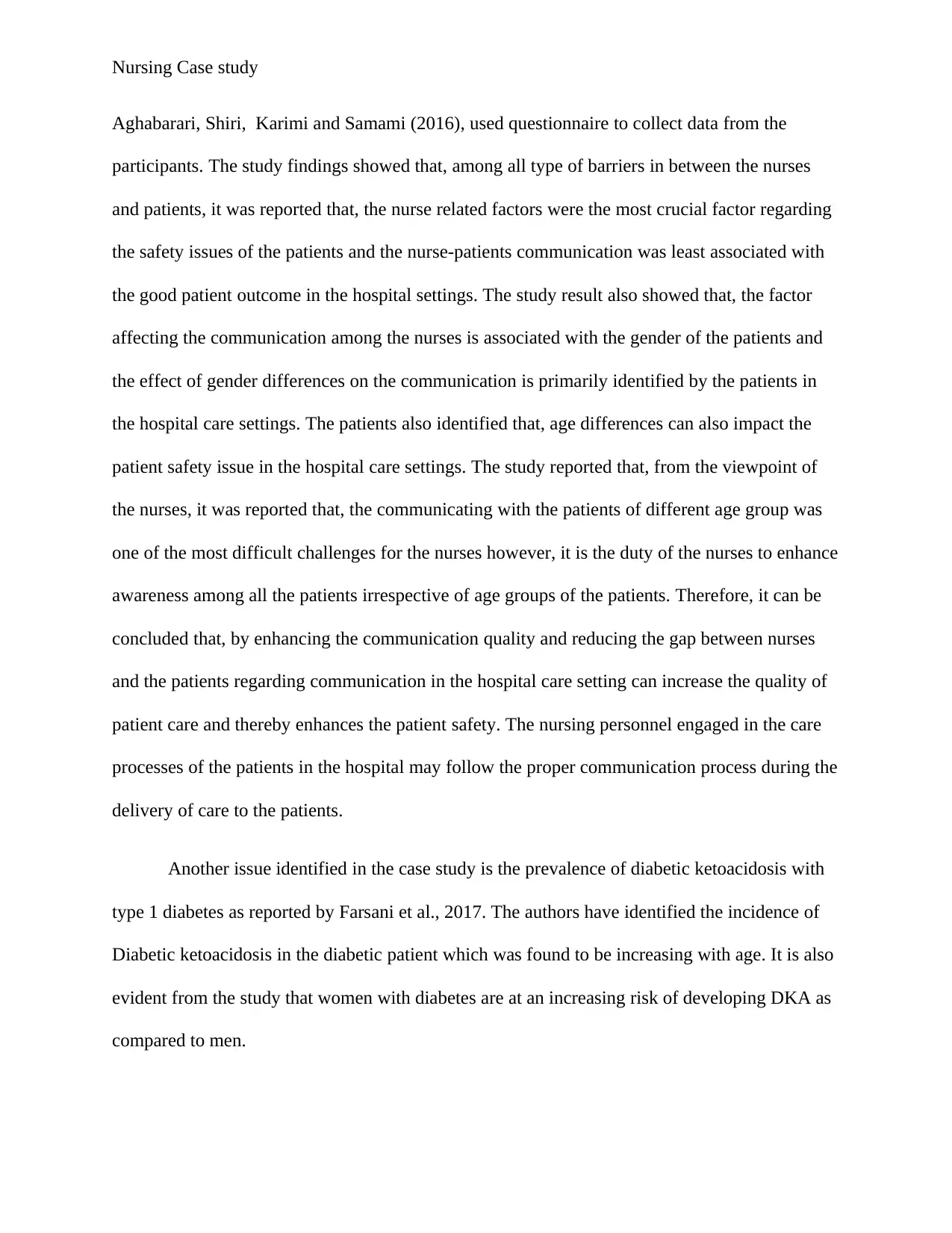
Nursing Case study
Aghabarari, Shiri, Karimi and Samami (2016), used questionnaire to collect data from the
participants. The study findings showed that, among all type of barriers in between the nurses
and patients, it was reported that, the nurse related factors were the most crucial factor regarding
the safety issues of the patients and the nurse-patients communication was least associated with
the good patient outcome in the hospital settings. The study result also showed that, the factor
affecting the communication among the nurses is associated with the gender of the patients and
the effect of gender differences on the communication is primarily identified by the patients in
the hospital care settings. The patients also identified that, age differences can also impact the
patient safety issue in the hospital care settings. The study reported that, from the viewpoint of
the nurses, it was reported that, the communicating with the patients of different age group was
one of the most difficult challenges for the nurses however, it is the duty of the nurses to enhance
awareness among all the patients irrespective of age groups of the patients. Therefore, it can be
concluded that, by enhancing the communication quality and reducing the gap between nurses
and the patients regarding communication in the hospital care setting can increase the quality of
patient care and thereby enhances the patient safety. The nursing personnel engaged in the care
processes of the patients in the hospital may follow the proper communication process during the
delivery of care to the patients.
Another issue identified in the case study is the prevalence of diabetic ketoacidosis with
type 1 diabetes as reported by Farsani et al., 2017. The authors have identified the incidence of
Diabetic ketoacidosis in the diabetic patient which was found to be increasing with age. It is also
evident from the study that women with diabetes are at an increasing risk of developing DKA as
compared to men.
Aghabarari, Shiri, Karimi and Samami (2016), used questionnaire to collect data from the
participants. The study findings showed that, among all type of barriers in between the nurses
and patients, it was reported that, the nurse related factors were the most crucial factor regarding
the safety issues of the patients and the nurse-patients communication was least associated with
the good patient outcome in the hospital settings. The study result also showed that, the factor
affecting the communication among the nurses is associated with the gender of the patients and
the effect of gender differences on the communication is primarily identified by the patients in
the hospital care settings. The patients also identified that, age differences can also impact the
patient safety issue in the hospital care settings. The study reported that, from the viewpoint of
the nurses, it was reported that, the communicating with the patients of different age group was
one of the most difficult challenges for the nurses however, it is the duty of the nurses to enhance
awareness among all the patients irrespective of age groups of the patients. Therefore, it can be
concluded that, by enhancing the communication quality and reducing the gap between nurses
and the patients regarding communication in the hospital care setting can increase the quality of
patient care and thereby enhances the patient safety. The nursing personnel engaged in the care
processes of the patients in the hospital may follow the proper communication process during the
delivery of care to the patients.
Another issue identified in the case study is the prevalence of diabetic ketoacidosis with
type 1 diabetes as reported by Farsani et al., 2017. The authors have identified the incidence of
Diabetic ketoacidosis in the diabetic patient which was found to be increasing with age. It is also
evident from the study that women with diabetes are at an increasing risk of developing DKA as
compared to men.
Paraphrase This Document
Need a fresh take? Get an instant paraphrase of this document with our AI Paraphraser
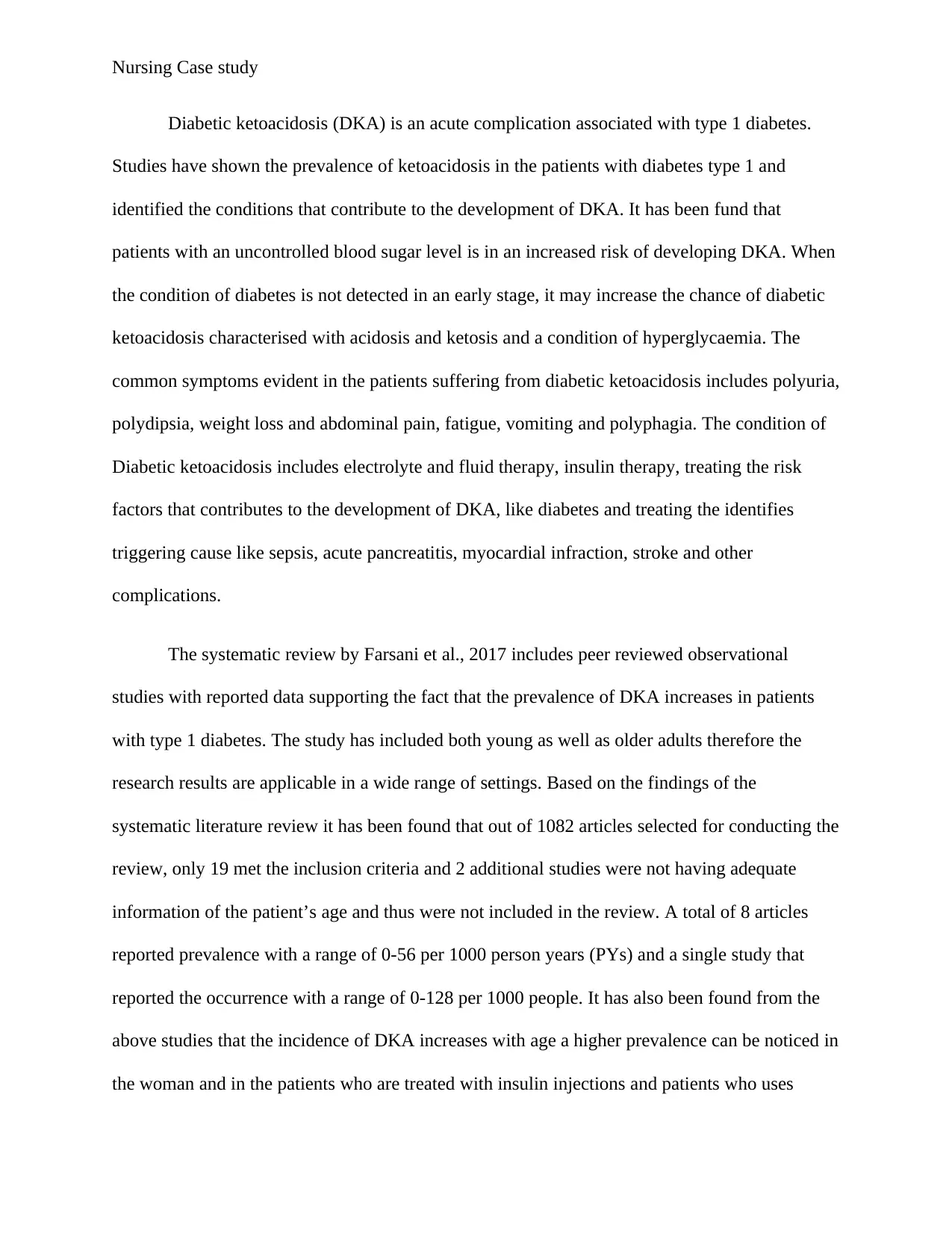
Nursing Case study
Diabetic ketoacidosis (DKA) is an acute complication associated with type 1 diabetes.
Studies have shown the prevalence of ketoacidosis in the patients with diabetes type 1 and
identified the conditions that contribute to the development of DKA. It has been fund that
patients with an uncontrolled blood sugar level is in an increased risk of developing DKA. When
the condition of diabetes is not detected in an early stage, it may increase the chance of diabetic
ketoacidosis characterised with acidosis and ketosis and a condition of hyperglycaemia. The
common symptoms evident in the patients suffering from diabetic ketoacidosis includes polyuria,
polydipsia, weight loss and abdominal pain, fatigue, vomiting and polyphagia. The condition of
Diabetic ketoacidosis includes electrolyte and fluid therapy, insulin therapy, treating the risk
factors that contributes to the development of DKA, like diabetes and treating the identifies
triggering cause like sepsis, acute pancreatitis, myocardial infraction, stroke and other
complications.
The systematic review by Farsani et al., 2017 includes peer reviewed observational
studies with reported data supporting the fact that the prevalence of DKA increases in patients
with type 1 diabetes. The study has included both young as well as older adults therefore the
research results are applicable in a wide range of settings. Based on the findings of the
systematic literature review it has been found that out of 1082 articles selected for conducting the
review, only 19 met the inclusion criteria and 2 additional studies were not having adequate
information of the patient’s age and thus were not included in the review. A total of 8 articles
reported prevalence with a range of 0-56 per 1000 person years (PYs) and a single study that
reported the occurrence with a range of 0-128 per 1000 people. It has also been found from the
above studies that the incidence of DKA increases with age a higher prevalence can be noticed in
the woman and in the patients who are treated with insulin injections and patients who uses
Diabetic ketoacidosis (DKA) is an acute complication associated with type 1 diabetes.
Studies have shown the prevalence of ketoacidosis in the patients with diabetes type 1 and
identified the conditions that contribute to the development of DKA. It has been fund that
patients with an uncontrolled blood sugar level is in an increased risk of developing DKA. When
the condition of diabetes is not detected in an early stage, it may increase the chance of diabetic
ketoacidosis characterised with acidosis and ketosis and a condition of hyperglycaemia. The
common symptoms evident in the patients suffering from diabetic ketoacidosis includes polyuria,
polydipsia, weight loss and abdominal pain, fatigue, vomiting and polyphagia. The condition of
Diabetic ketoacidosis includes electrolyte and fluid therapy, insulin therapy, treating the risk
factors that contributes to the development of DKA, like diabetes and treating the identifies
triggering cause like sepsis, acute pancreatitis, myocardial infraction, stroke and other
complications.
The systematic review by Farsani et al., 2017 includes peer reviewed observational
studies with reported data supporting the fact that the prevalence of DKA increases in patients
with type 1 diabetes. The study has included both young as well as older adults therefore the
research results are applicable in a wide range of settings. Based on the findings of the
systematic literature review it has been found that out of 1082 articles selected for conducting the
review, only 19 met the inclusion criteria and 2 additional studies were not having adequate
information of the patient’s age and thus were not included in the review. A total of 8 articles
reported prevalence with a range of 0-56 per 1000 person years (PYs) and a single study that
reported the occurrence with a range of 0-128 per 1000 people. It has also been found from the
above studies that the incidence of DKA increases with age a higher prevalence can be noticed in
the woman and in the patients who are treated with insulin injections and patients who uses
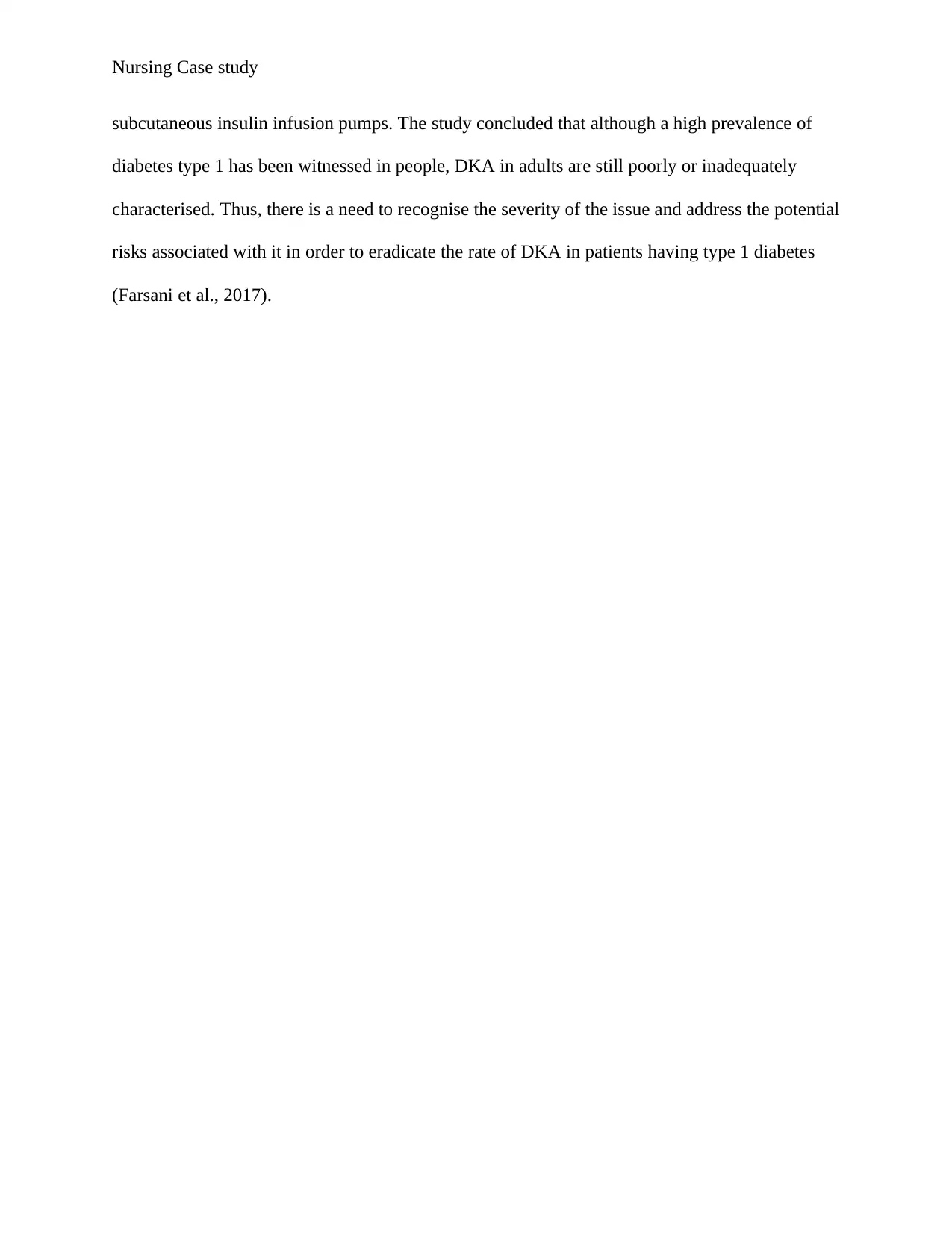
Nursing Case study
subcutaneous insulin infusion pumps. The study concluded that although a high prevalence of
diabetes type 1 has been witnessed in people, DKA in adults are still poorly or inadequately
characterised. Thus, there is a need to recognise the severity of the issue and address the potential
risks associated with it in order to eradicate the rate of DKA in patients having type 1 diabetes
(Farsani et al., 2017).
subcutaneous insulin infusion pumps. The study concluded that although a high prevalence of
diabetes type 1 has been witnessed in people, DKA in adults are still poorly or inadequately
characterised. Thus, there is a need to recognise the severity of the issue and address the potential
risks associated with it in order to eradicate the rate of DKA in patients having type 1 diabetes
(Farsani et al., 2017).
⊘ This is a preview!⊘
Do you want full access?
Subscribe today to unlock all pages.

Trusted by 1+ million students worldwide
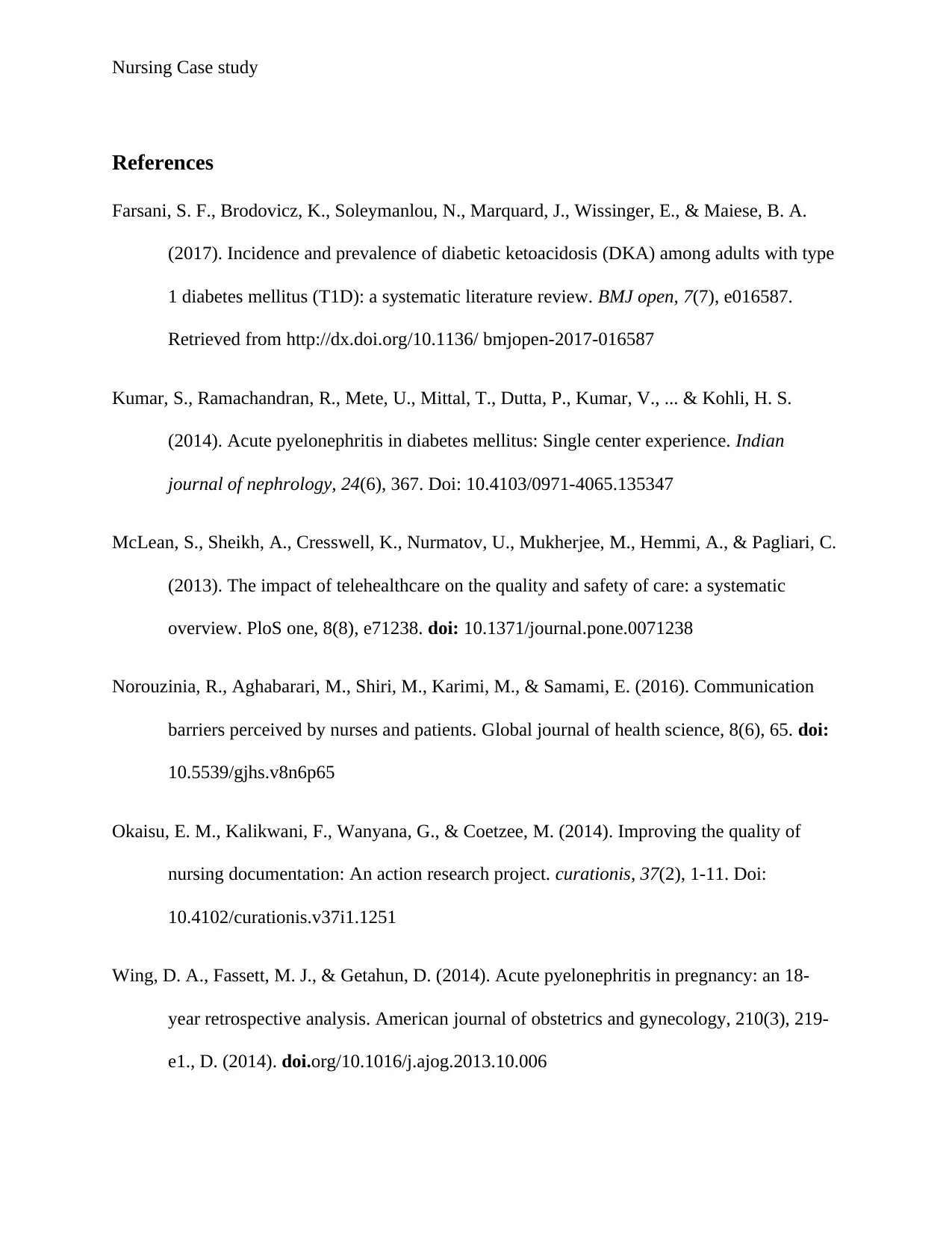
Nursing Case study
References
Farsani, S. F., Brodovicz, K., Soleymanlou, N., Marquard, J., Wissinger, E., & Maiese, B. A.
(2017). Incidence and prevalence of diabetic ketoacidosis (DKA) among adults with type
1 diabetes mellitus (T1D): a systematic literature review. BMJ open, 7(7), e016587.
Retrieved from http://dx.doi.org/10.1136/ bmjopen-2017-016587
Kumar, S., Ramachandran, R., Mete, U., Mittal, T., Dutta, P., Kumar, V., ... & Kohli, H. S.
(2014). Acute pyelonephritis in diabetes mellitus: Single center experience. Indian
journal of nephrology, 24(6), 367. Doi: 10.4103/0971-4065.135347
McLean, S., Sheikh, A., Cresswell, K., Nurmatov, U., Mukherjee, M., Hemmi, A., & Pagliari, C.
(2013). The impact of telehealthcare on the quality and safety of care: a systematic
overview. PloS one, 8(8), e71238. doi: 10.1371/journal.pone.0071238
Norouzinia, R., Aghabarari, M., Shiri, M., Karimi, M., & Samami, E. (2016). Communication
barriers perceived by nurses and patients. Global journal of health science, 8(6), 65. doi:
10.5539/gjhs.v8n6p65
Okaisu, E. M., Kalikwani, F., Wanyana, G., & Coetzee, M. (2014). Improving the quality of
nursing documentation: An action research project. curationis, 37(2), 1-11. Doi:
10.4102/curationis.v37i1.1251
Wing, D. A., Fassett, M. J., & Getahun, D. (2014). Acute pyelonephritis in pregnancy: an 18-
year retrospective analysis. American journal of obstetrics and gynecology, 210(3), 219-
e1., D. (2014). doi.org/10.1016/j.ajog.2013.10.006
References
Farsani, S. F., Brodovicz, K., Soleymanlou, N., Marquard, J., Wissinger, E., & Maiese, B. A.
(2017). Incidence and prevalence of diabetic ketoacidosis (DKA) among adults with type
1 diabetes mellitus (T1D): a systematic literature review. BMJ open, 7(7), e016587.
Retrieved from http://dx.doi.org/10.1136/ bmjopen-2017-016587
Kumar, S., Ramachandran, R., Mete, U., Mittal, T., Dutta, P., Kumar, V., ... & Kohli, H. S.
(2014). Acute pyelonephritis in diabetes mellitus: Single center experience. Indian
journal of nephrology, 24(6), 367. Doi: 10.4103/0971-4065.135347
McLean, S., Sheikh, A., Cresswell, K., Nurmatov, U., Mukherjee, M., Hemmi, A., & Pagliari, C.
(2013). The impact of telehealthcare on the quality and safety of care: a systematic
overview. PloS one, 8(8), e71238. doi: 10.1371/journal.pone.0071238
Norouzinia, R., Aghabarari, M., Shiri, M., Karimi, M., & Samami, E. (2016). Communication
barriers perceived by nurses and patients. Global journal of health science, 8(6), 65. doi:
10.5539/gjhs.v8n6p65
Okaisu, E. M., Kalikwani, F., Wanyana, G., & Coetzee, M. (2014). Improving the quality of
nursing documentation: An action research project. curationis, 37(2), 1-11. Doi:
10.4102/curationis.v37i1.1251
Wing, D. A., Fassett, M. J., & Getahun, D. (2014). Acute pyelonephritis in pregnancy: an 18-
year retrospective analysis. American journal of obstetrics and gynecology, 210(3), 219-
e1., D. (2014). doi.org/10.1016/j.ajog.2013.10.006
1 out of 10
Related Documents
Your All-in-One AI-Powered Toolkit for Academic Success.
+13062052269
info@desklib.com
Available 24*7 on WhatsApp / Email
![[object Object]](/_next/static/media/star-bottom.7253800d.svg)
Unlock your academic potential
Copyright © 2020–2025 A2Z Services. All Rights Reserved. Developed and managed by ZUCOL.





